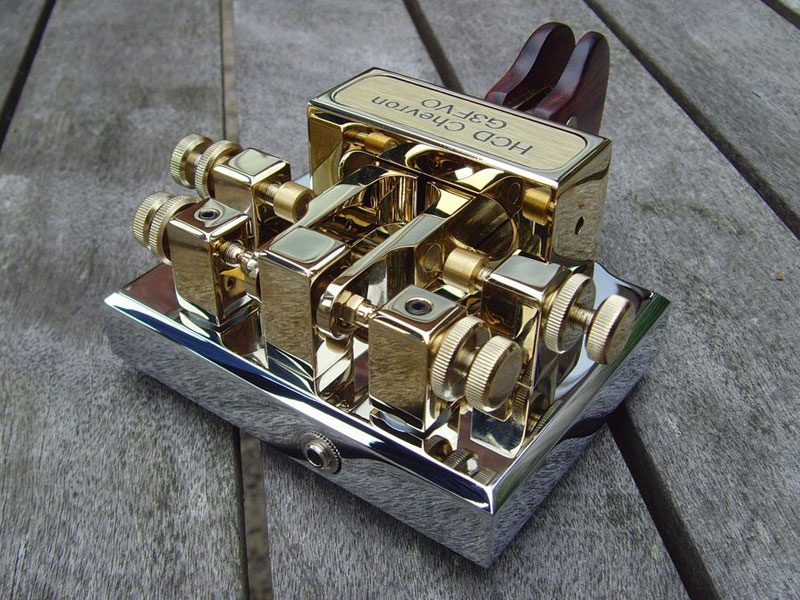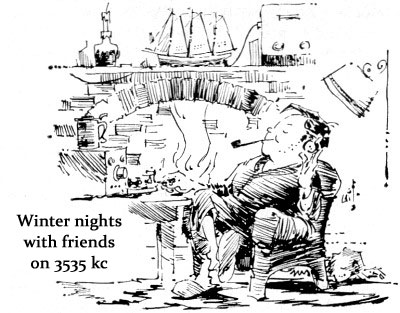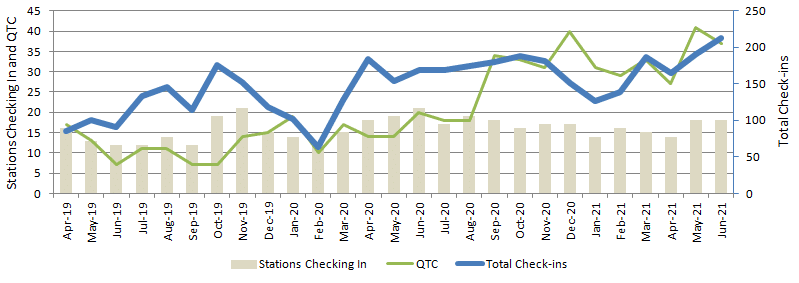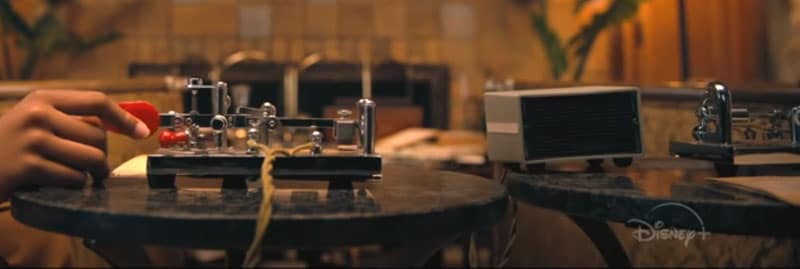This is a fortnightly newsletter about the New Zealand Net. If you would like to be notified by email when a new edition is published, please contact ZL1NZ.
Browse our Newsletter Archive and List of Net Tips.
Featured key

HCD Chevron twin lever paddles with Cocobolo hardwood finger pieces. Photo: Chevron Keys
It would be hard to imagine prettier looking keys than the Chevron paddles made by Kevin Gunstone M0AGA.
Kevin hand-makes two models of dual-lever paddle. The HCD Chevron (pictured) has the magnetic tensioning posts fitted to the base. The AGA Chevron has a larger lever block that incorporates the magnetic tensioning adjusters. Both models are brass with chrome bases and gold-plated upper components, including contacts.
* If you have an interesting key for this feature, please send me a nice clear photo and a few words describing it.
Quick notes
 Ngā mihi o Matariki, te tau hou Māori.
Ngā mihi o Matariki, te tau hou Māori.
Several people have contacted me in recent weeks to say that, although they do not check in to the Net, they do listen. Typically this is because they are still learning Morse Code and don’t feel they are quite ready to dive in. If you are one of these listeners, we’re glad to have you QSX 3535, and hope to hear your QNI when you feel ready.
Congratulations to NZ Net regulars Paul ZL1AJY and Barry ZL2LN for placing first-equal and third, respectively, in New Zealand’s most exciting amateur radio contest (Straight Key Night, of course). Many other NZ Netters were heard during SKN and scored well. You can see the full SKN results here.
Straight Key Night is looking for a new manager. If you enjoy participating in SKN, imagine how much fun you could have actually managing the event! I have decided to retire as SKN Manager, so now’s your chance to take it on. If you’re interested, please contact me so we can organise the hand-over.
Cartoon: Gildersleeve
Net numbers

June was another record-breaking month for the New Zealand Net, with 213 check-ins. Wow! Our previous record was 188 check-ins in Oct of last year. Thanks everyone for supporting the NZ Net.
Here is the monthly report:
NR62 R ZL1NZ 46/43 AUCKLAND 0900Z 1JUL21 = NZ NET = JUNE QNI ZL1AJY 12 ZL1ANY 19 ZL1BWG 17 ZL1GQ 2 ZL1NZ 20 ZL2GD 19 ZL2GVA 19 ZL2KE 14 ZL2LN 9 ZL2WT 15 ZL3RIK 2 ZL3TK 13 ZL4CU 5 ZL4FZ 3 ZL4KX 16 VK2GBR 1 VK3DRQ 22 VK4PN 5 RECORD TOTAL 213 QTC 37 = ZL1NZ
Photo flashback

This time, the photo is contemporary, but the subject is historical. It’s a little item of military surplus which is currently for sale on eBay in the USA.
I have heard people talk about their “shack in a box”. I guess this is what they mean!
Imagine mounting it on a flat-bed truck and heading out do Field Day with a gen-set in tow for some CW fun! Although eBay says the seller “may not ship to New Zealand,” here’s the info so we can all dream.
 MRT-9 communication shed
MRT-9 communication shed
It contains two R390A receivers in good working order and tuned up, two T-368 transmitters excellent working condition, one tuned for 40m, and the other tuned for 80m. Power output is over 500 watts AM. Various power meters, power control panel, heater, blowers, and an add on internal a/c unit(not pictured), along with Kleinschmidt teletype page printer, typing re-perforator, RTTY decoders, main control panel for the transmitter/receiver selection combo/ microphone, plus original manual with wiring diagrams and 2-120 volt heavy duty power cords (plugged in). The system is fully operational. I currently have a 5 band vertical on one corner with the original 3 vertical antennas on the other 3. There are antenna tuners for each. Also in one of the racks of equipment are several field intercoms, and it is all original. The best way to pick up is a roll-off tilt bed truck. Also, we can load this with our 12,000 pound forklift if you have some sort of flat bed trailer that can handle it. US$14,500.
The King is Dead, Long Live the King
By Stan ZL3TK
‘The Morse code is dead, long live the Morse code!’ is analogous to the old meme which announces the death of a monarch and conveys good tidings for the ascension of his successor to the throne.
When the French Navy ceased using Morse code on 31 January 1997, the final message transmitted was “Calling all. This is our last cry before our eternal silence.”
The ‘king hit’ slowly administered to Morse code throughout the 1990s when global communications administrators declared it obsolete may well have led to its demise but, au contraire mes amis, today the amateur-driven ‘son of Morse’ is the living, breathing successor to the old Morse that ‘they’ failed to kill off.
The mere existence of the NZ Net ensures that Morse is not going to die any time soon. My recent attempt at sending a slightly cryptic – some might say ‘boring’ – QNC on the net resulted in a completely unexpected result, and thus proves the truth of the adapted meme. It was alleged soon after the event, that five QTCs on one subject, all addressed to one operator in a single NZ Net session, may have set some sort of a record. I can’t say whether it has or not, but it did surprise and gladden me. Next day, as usual, a brief email was sent to all those who contributed to the success of the exercise. A reply arrived from one chap who wrote, “Well done on getting so many replies. I had nothing to do with it.”
Well, I beg to differ and respectfully suggest that such modesty is typical of the sender, but in this context, quite misplaced. Any ideas as to who exactly, over a long period, has provided all manner of resources, including websites, newsletters, encouragement to the troops, and has proven to be totally reliable, as well as a very willing and congenial Elmer to those seeking success on the NZ Net? To prove my point, please observe two examples of such contributions in the accompanying photograph: first, the radiogram forms themselves, and second, the simple but effective spring paper-clip archive system, both created and generously shared by the same chap who claims to have had “… nothing to do with it.”

Make your own judgment, but for me, the support, drive, patience and esprit de corps that is so obvious among those who log into our contemporary Morse net, has caused a welcome reversal from my being on the cusp of retiring from ham radio a short time ago.
The photograph shows my original QNC held by the orange-labelled paper clip. Beneath and to the right of the green-labelled paper clip, the five QTCs in response, all with the same receive date annotated at the top left corner.
Our VK OM quite correctly pointed out a spelling mistake in my QNC; did anyone else find it?
A great effort guys – 73 and 77.
Revealed: the key in the movie trailer
The previous newsletter featured the video trailer for Disney’s new series The Mysterious Benedict Society. The trailer included two very fleeting shots of a pair of children with Morse keys. I asked what type of key was being used by the boy (since we could see his key better than the girl’s).

They keys are both semi-automatics (bugs) made by Vibroplex, and they are both Deluxe versions, as we can tell from their chromed bases and red finger pieces.
But the keys are quite different.
The boy’s key (on the left in the screen grab above) is a Lightning Deluxe and the girl’s is an Original Deluxe. Both are excellent keys, but the Lightning was slightly cheaper. Where the Original has rounded castings for the main frame and damper, the Lightning uses standard metal components (flat stock and rod) that are screwed together. Apparently this was an advantage in the eyes of the US military during WW2, as they felt the Lightning (originally known as the Vibroplex Model 6) would be easier to repair in the field. So Vibroplex made thousands of them for the military, where they were given the standard J-36 designation supplied to all military “speed keys”.
Looking at the photo above, the Lightning is distinguished by:
- its tall, fabricated main frame (rather than the rounded cast frame of the Original)
- its square, fabricated M-shaped (or “goalposts”) damper (rather than the cast L-shaped damper of the Original which can also be seen in the photo)
- its flat pendulum and square adjustable weight (rather than the round pendulum and cylindrical weight of the Original)
Bonus points for noticing that it is a right-handed version too 🙂
The Lightning, produced from the mid 1920s until 1979, was not the cheapest Vibroplex during that era. There were also the Champion and Zephyr models which looked identical expect for simpler dampers, plus the Zephyr was on a 3-inch wide base, rather than the standard 3.5-inch base.
Conversely, the Original was not the top of the range. The Presentation was the same as the Original, but with a 24k gold-plated top plate and an adjustable mainspring. Originals and Presentations are still sold by Vibroplex, although the Presentations no longer have adjustable mainsprings.
Congratulations to Stan ZL3TK who was first in with the correct answer, followed by Gerard ZL2VGA and Bruce ZL1BWG. These operators obviously know their Vibroplexes.
Video: Norddeich Radio / DAN
This is an interesting promotional video. Lots of Junker straight keys and some great telegraphers. Not a bug or a paddle key in sight!
Audio challenge
Now that you have seen the Norddeich Radio / DAN video above, you’ll be in good shape for our audio challenge.
Here is a recording of DAN on 31 December 1995 announcing that they are closing the 500 kHz radiotelegraphy service, and that another station would be assuming SAR monitoring on 500 kHz for the German SAR area.
Following the announcement from DAN, many stations called them to offer best wishes. One call, which you can hear in the recording, was from the station that would be taking over the SAR monitoring. Their brief message to DAN ends with a rather interesting single word, actually an abbreviation of that word which radio amateurs will recognise.
Challenge: What is the abbreviation and the word it represents? Send me your answer via email or radiogram.
In our previous newsletter, the Audio Challenge contained text from the New Zealand Bill of Rights Act (1990). I received the correct answer first from ZL2KE, then from ZL1ANY, ZL1BBW, ZL1ROK, ZL1WAL, ZL2GVA and ZL3TK.
Preservation: Western Bay Museum
The Western Bay Museum is located in the historic Old Fire Station in Katikati, in the western Bay of Plenty.
One of their volunteers contacted me a few weeks ago, looking for any information about three Morse keys in the museum’s collection. So maybe you can help me with that!

Two views of the three Morse keys at Western Bay Museum
I’m sorry the photos are so small. I have not been successful in getting better ones from the museum yet.
All three appear to be on timber bases. The one with the grey base has the word Ultimate in script on the lever, suggesting that was its brand name. The others apparently have no marks at all.
OK guys, what can you tell me about any of these?
Net tip:
I received the following question from Gerard ZL2GVA:
“On Friday Manny checked in, and I recognised his call but not much more. How would I have asked if there was someone that could copy Manny better? Would “ANY QSP VK3DRQ?” be the way to do this?”
I think Gerard’s suggestion is fine. Like many things on the Net, we don’t have a prescribed way to do this, and sometimes we need to improvise, and even bend the rules a bit.
“QSP (callsign)” means “I can relay TO (callsign)”
“QSP (callsign)?” means “Can you relay TO (callsign)?”
Despite these definitions, you will often hear NCS ask for check-ins and, if they hear nothing, then ask “ANY QSP?” Technically, that’s an incorrect use of QSP, but I can’t think of a signal that means “Can you relay FROM (callsign)?” so we use “QSP?” and the context makes our meaning clear (at least I hope it does).
If there is risk of confusion, then we might supplement the Q Signal with other information. For example, in Gerard’s situation, he could ask:
“ANY QSP FM VK3DRQ?”
That way, no will think he is asking for someone to relay his signals TO VK3DRQ.
If anyone has a better suggestion, please let me know so I can share it in the next NZ Net News.
Advertising archive

QST, January 1970
In addition to their Autronic single-lever paddle, Electrophysics Corporation also made the Autronic electronic keyer. Introduced in 1961, it used germanium transistors.
The prices in the advertisement are interesting. Nowadays, electronics are cheap, but a nice set of paddles can cost hundreds of dollars.
Suggestions?
If you have suggestions on how to make the NZ Net better, or things you’d like to see covered in these updates, please contact ZL1NZ. You might even like to write something for the newsletter.
Thanks for reading, and I hope to see you soon on the NZ Net!
—
Neil Sanderson ZL1NZ, Net Manager
New Zealand Net (NZ NET)
3535.0 kHz at 9pm NZT Mon-Fri




